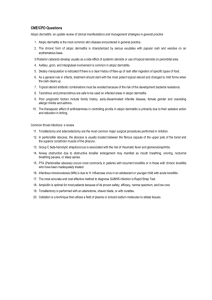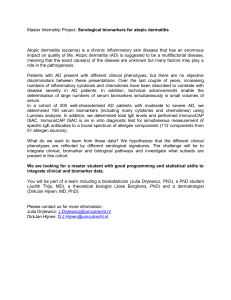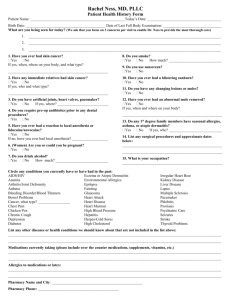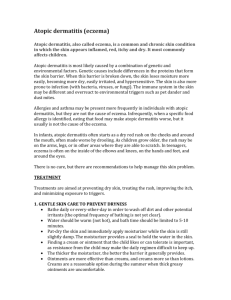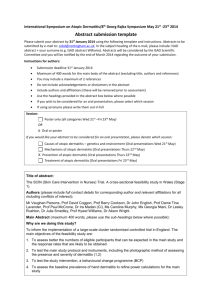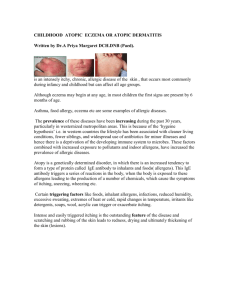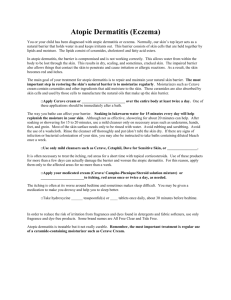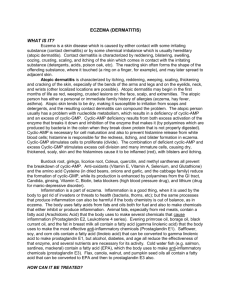Dermatitis Atópica y prúrigos alérgicos - PIEL
advertisement
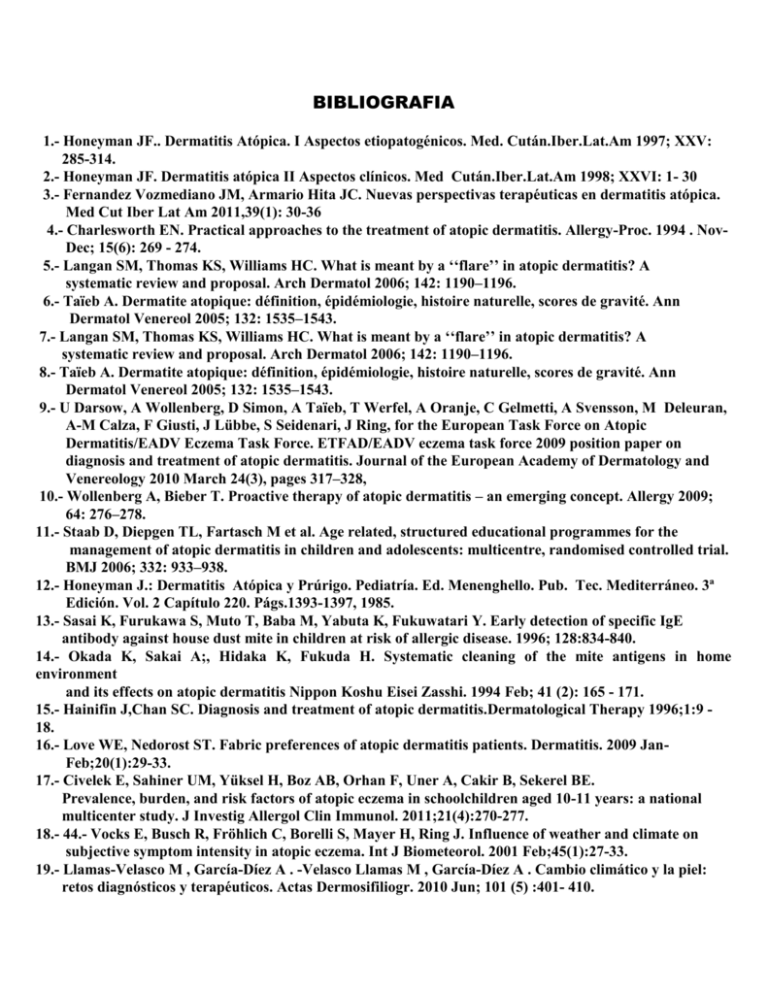
BIBLIOGRAFIA
1.- Honeyman JF.. Dermatitis Atópica. I Aspectos etiopatogénicos. Med. Cután.Iber.Lat.Am 1997; XXV:
285-314.
2.- Honeyman JF. Dermatitis atópica II Aspectos clínicos. Med Cután.Iber.Lat.Am 1998; XXVI: 1- 30
3.- Fernandez Vozmediano JM, Armario Hita JC. Nuevas perspectivas terapéuticas en dermatitis atópica.
Med Cut Iber Lat Am 2011,39(1): 30-36
4.- Charlesworth EN. Practical approaches to the treatment of atopic dermatitis. Allergy-Proc. 1994 . NovDec; 15(6): 269 - 274.
5.- Langan SM, Thomas KS, Williams HC. What is meant by a ‘‘flare’’ in atopic dermatitis? A
systematic review and proposal. Arch Dermatol 2006; 142: 1190–1196.
6.- Taïeb A. Dermatite atopique: définition, épidémiologie, histoire naturelle, scores de gravité. Ann
Dermatol Venereol 2005; 132: 1535–1543.
7.- Langan SM, Thomas KS, Williams HC. What is meant by a ‘‘flare’’ in atopic dermatitis? A
systematic review and proposal. Arch Dermatol 2006; 142: 1190–1196.
8.- Taïeb A. Dermatite atopique: définition, épidémiologie, histoire naturelle, scores de gravité. Ann
Dermatol Venereol 2005; 132: 1535–1543.
9.- U Darsow, A Wollenberg, D Simon, A Taïeb, T Werfel, A Oranje, C Gelmetti, A Svensson, M Deleuran,
A-M Calza, F Giusti, J Lübbe, S Seidenari, J Ring, for the European Task Force on Atopic
Dermatitis/EADV Eczema Task Force. ETFAD/EADV eczema task force 2009 position paper on
diagnosis and treatment of atopic dermatitis. Journal of the European Academy of Dermatology and
Venereology 2010 March 24(3), pages 317–328,
10.- Wollenberg A, Bieber T. Proactive therapy of atopic dermatitis – an emerging concept. Allergy 2009;
64: 276–278.
11.- Staab D, Diepgen TL, Fartasch M et al. Age related, structured educational programmes for the
management of atopic dermatitis in children and adolescents: multicentre, randomised controlled trial.
BMJ 2006; 332: 933–938.
12.- Honeyman J.: Dermatitis Atópica y Prúrigo. Pediatría. Ed. Menenghello. Pub. Tec. Mediterráneo. 3ª
Edición. Vol. 2 Capítulo 220. Págs.1393-1397, 1985.
13.- Sasai K, Furukawa S, Muto T, Baba M, Yabuta K, Fukuwatari Y. Early detection of specific IgE
antibody against house dust mite in children at risk of allergic disease. 1996; 128:834-840.
14.- Okada K, Sakai A;, Hidaka K, Fukuda H. Systematic cleaning of the mite antigens in home
environment
and its effects on atopic dermatitis Nippon Koshu Eisei Zasshi. 1994 Feb; 41 (2): 165 - 171.
15.- Hainifin J,Chan SC. Diagnosis and treatment of atopic dermatitis.Dermatological Therapy 1996;1:9 18.
16.- Love WE, Nedorost ST. Fabric preferences of atopic dermatitis patients. Dermatitis. 2009 JanFeb;20(1):29-33.
17.- Civelek E, Sahiner UM, Yüksel H, Boz AB, Orhan F, Uner A, Cakir B, Sekerel BE.
Prevalence, burden, and risk factors of atopic eczema in schoolchildren aged 10-11 years: a national
multicenter study. J Investig Allergol Clin Immunol. 2011;21(4):270-277.
18.- 44.- Vocks E, Busch R, Fröhlich C, Borelli S, Mayer H, Ring J. Influence of weather and climate on
subjective symptom intensity in atopic eczema. Int J Biometeorol. 2001 Feb;45(1):27-33.
19.- Llamas-Velasco M , García-Díez A . -Velasco Llamas M , García-Díez A . Cambio climático y la piel:
retos diagnósticos y terapéuticos. Actas Dermosifiliogr. 2010 Jun; 101 (5) :401- 410.
2
20.- Llamas-Velasco M, García-Díez A.Climatic change and skin: diagnostic and therapeutic challenges]
Actas Dermosifiliogr. 2010 Jun;101(5):403-412.
21.- Rudzki E, Samochocki Z, Rebandel P y cols.A. Frequency and significance of the major and minor
features of Hanifin and Rajka among patients with atopic dermatitis.Dermatology.1994; 189(1): 40 46.
22.- Forsdyke H, Watts J. Skin care in atopic eczema.Prof-Nurse. 1994 Oct; 10(1): 36-40.
23.- Donald S Atopic eczema: management and control. Paediatr-Nurs. 1995 Mar; 7(2): 29-31, 33-35; quiz
24.- Dahl MV. Atopic Dermatitis. En Demis DJ : Clinical Dermatology. J.B. Lippincott Company.
Philadelphia. U.S.A. Revisión 23 (1996). Vol 3. Unit 13-3 Pp 1- 30.
25.- Salzer B, Schuch S, Rupprecht M, Hornstein OP. Gruppensport als adjuvante Therapie fur Patienten
mit atopischem Ekzem. Hautarzt. 1994 Nov; 45(11): 751 - 755 . (Grupo de deportes como tratamiento
coadyuvante en pacientes con dermatitis atópica).
26.- Tupker RA, Coenraads PJ, Fidler V y cols. Irritant susceptibility and weal and flare reactions to
bioactive agents in atopic dermatitis. I. Influence of disease severity. Br J Dermatol. 1995 Sep; 133(3):
358 - 364.
27.- Loden M. Biophysical properties of dry atopic and normal skin with special reference to effects of skin
care products. Acta Derm Venereol (Suppl) Stockh. 1995; 192: 1 - 48.
28.- Bridgman A. The use of wet wrap dressings for eczema. Paediatr Nurs. 1995 Mar; 7 (2): 24 - 27
29.- Lee JH, Lee SJ, Kim DS, The effect of wet-wrap dressing on epidermal barrier in patients with atopic
dermatitis D BangJournal of the European Academy of Dermatology and Venereology. Volume 21,
Issue 10, pages 1360–1368, November 2007
30.- Huang JT, Rademaker A, Paller AS. Dilute bleach baths for Staphylococcus aureus colonization in
atopic dermatitis to decrease disease severity. Arch Dermatol. 2011 Feb;147(2):246-247.Comment on
Arch Dermatol. 2010 May;146(5):541-543.
31.- Huang JT, Abrams M, Tlougan B, Rademaker A, Paller AS. Treatment of Staphylococcus aureus
colonization in atopic dermatitis decreases disease severity. Pediatrics. 2009 May;123(5):e808-814.
32.- Kubota K, Tamura K, Take H y cols. Dependence on very hot hot-spring bathing in a refractory case of
atopic dermatitis. J Med. 1994; 25 (5): 333 - 336
33.- Vocks E, Engst R, Karl S. Dermatologische Klimatherapie-Definition, Indikationen und
gesundheitspolitische Notwendigkeit. Rehabilitation-Stuttg. 1995 Aug; 34 (3): 148 - 153.
34.- Zimmermann J, Utermann S. Photosoletherapie bei Patienten mit Psoriasis und Neurodermitis atopica.
Hautarzt. 1994 Dec; 45 (12): 849 - 853.
35.- Puryshev EA . Effektivnost' speleoterapii pri atopicheskom dermatite u detei. Vopr Kurortol Fizioter
Lech Fiz Kult. 1994 Jul-Aug (4): 34 - 35.
36.- Aalto-Korte K. Improvement of skin barrier function during treatment of atopic dermatitis. J Am Acad
Dermatol. 1995 Dec; 33 (6): 969 - 972.
37.- Darsow U,Wollenberg A,Simon D,Taïeb A,Werfel T,Oranje A,Gelmetti C,Svensson A,Deleuran M,
Calza A-M,Giusti F,Lübbe J,Seidenari S,Ring J, for the European Task Force on Atopic
Dermatitis/EADV Eczema Task Force. ETFAD/EADV eczema task force 2009 position paper on
diagnosis and treatment of atopic dermatitis. J Eur Acad Dermatol Venereol. 2010 Mar;24(3):317-328.
38.- Weidinger S, O’Sullivan M, Illig T et al. Filaggrin mutations, atopic eczema, hay fever, and asthma in
2
3
children. J Allergy Clin Immunol 2008; 121: 1203–1209.
39.- Chamlin SL, Frieden IJ, Fowler A et al. Ceramide-dominant, barrier-repair lipids improve childhood
atopic dermatitis. Arch Dermatol 2001; 137: 1110–1112.
40.- Grimalt R, Mengeaud V, Cambazard F, Study Investigators’ Group. The steroid-sparing effect of an
emollient therapy in infants with atopic dermatitis: a randomized controlled study. Dermatology 2007;
214: 61–67.
41.- Boussault P, Léauté-Labrèze C, Saubusse E et al. Oat sensitization in children with atopic dermatitis:
prevalence, risks and associated factors. Allergy 2007; 62: 1251–1256.
42.- Simpson EL. Atopic dermatitis: a review of topical treatment options.
Curr Med Res Opin. 2010 Mar;26(3):633-640.
43.- Walling HW, Swick BL. Update on the management of chronic eczema: new approaches and emerging
treatment options. Clin Cosmet Investig Dermatol. 2010 Jul 28;3:99-117.
44.- Eichenfield LF, McCollum A, Msika P. The benefits of sunflower oleodistillate (SOD) in pediatric
dermatology. Pediatr Dermatol. 2009 Nov-Dec;26(6):669-675.
45.- Bayles B, Usatine R. Evening primrose oil. Am Fam Physician. 2009 Dec 15;80(12):1405-1408.
46.- Kircik L. A nonsteroidal lamellar matrix cream containing palmyitoyethanolamide for the treatment of
atopic dermatitis. J Drugs Dermatol. 2010 Apr;9(4):334-338.
47.- Boguniewicz M, Zeichner JA, Eichenfield LF, Hebert AA, Jarratt M, Lucky AW, Paller AS.
MAS063DP is effective monotherapy for mild to moderate atopic dermatitis in infants and children: a
multicenter, randomized, vehicle-controlled study. J Pediatr 2008; 152: 854-859.
48.- Eberlein B, Eicke C, Reinhardt HW, Ring J. Adjuvant treatment of atopic eczema: assessment of an
emollient containing Npalmitoylethanolamine (ATOPA study). J Eur Acad Dermatol Venereol 2008;
49.- Hajime T, Manabu M,Kazufumi Y, Mariko S, Takahiro T, Yuriko M Hiroyuki K, Kitajima Yasuo K,
Clinical Evaluation of Efficacy of Locobase REPAIR for Treatment of Atopic Dermatitis and Asteatotic
Eczema in Children. Skin Research. 2004. VOL.3 (3) : 306-315
50.- Tsiskarishvili NV, Katsitadze EG, Eradze MSh, Tsiskarishvili NI.Therapeutic efficacy of locobase
cream in the treatment of atopic dermatitis. Georgian Med News. 2009 Dec;(177):55-59.
22: 73-82.
51.- Stainer R, Matthews S, Arshad SH, McDonald S, Robinson J, Schapira C, Foote KD, Baird-Snell M,
Gregory T, Pollock I, Stevens MT, Edwards AM. Efficacy and acceptability of a new topical skin lotion
of sodium cromoglicate (Altoderm) in atopic dermatitis in children aged 2-12 years: a double-blind,
randomized, placebo-controlled trial. Br J Dermatol. 2005 Feb;152(2):334-341.
52.- Vieira Dos Santos R, Magerl M, Martus P, Zuberbier T, Church MK, Escribano L, Maurer M.Topical
sodium cromoglicate relieves allergen- and histamine-induced dermal pruritus. Br J Dermatol. 2010
Mar;162(3):674-676.
53.- Sugarman JL, Parish LC. Efficacy of a lipid-based barrier repair formulation in moderate-to-severe
pediatric atopic dermatitis. J Drugs Dermatol. 2009 Dec;8(12):1106-1111.
54.- Abramovits W et al. A multicenter, randomized, vehicle-controlled clinical study to examine the
efficacy and safety of MAS063D ('Atopiclair/Dersura') in the management of mild to moderate atopic
dermatitis in adults. J. Drugs Dermatol. 2006;5(3):236-244.
3
4
55.- Patrizi A, Capitano B, Neri I, Giacomini F, Sinagra JL, Raone B, Berardesca E. A doublé- blind,
randomized, vehicle-controlled clinical study to evaluate the efficacy and safety of MAS063DP
(ATOPICLAIR) in the management of atopic dermatitis in paediatric patients. Pediatr Allergy
Immunol 2008; 19: 619-625.
56.- Reuter J, Merfort I, Schempp CM.Botanicals in dermatology: an evidence-based review.Am J Clin
Dermatol. 2010;11(4):247-267.
57.- Patzelt-Wenczler R, Ponce-Pöschl E. Proof of efficacy of Kamillosan(R) cream in atopic eczema. Eur J
Med Res. 2000 Apr 19;5 (4):171-175.
58.- Higaki S, Kitagawa T, Morohashi M, Yamagishi T. Efficacy of Shiunko for the treatment of atopic
dermatitis. J Int Med Res. 1999 May-Jun;27(3):143-147.
59.- Werfel T, Claes C, Kulp W, Greiner W, von der Schulenburg JM. Therapy of atopic eczema. GMS
Health Technol Assess. 2006 Oct 6;2:Doc19.
60.- Hoare C, Li Wan Po A, Williams H. Systematic review of treatments for atopic eczema. Health
Technol Assess 2000; 4: 1–191.
61.- Van der Meer JB, Glazenburg EJ, Mulder PG, Eggink HF, Coenraads PJ. The management of
moderate to severe atopic dermatitis in adults with topical fluticasone propionate. The Netherlands
Adult Atopic Dermatitis Study Group. Br J Dermatol 1999; 140: 1114–1121.
62.- Hanifin J, Gupta AK, Rajagopalan R. Intermittent dosing of fluticasone propionate cream for reducing
the risk of relapse in atopic dermatitis patients. Br J Dermatol 2002; 147: 528–537.
63.- Berth-Jones J, Damstra RJ, Golsch S et al. Twice weekly fluticasone propionate added to emollient
maintenance treatment to reduce risk of relapse in atopic dermatitis: randomised, double blind, parallel
group study. BMJ 2003; 326: 1367.
64.- Glazenburg EJ, Wolkerstorfer A, Gerretsen AL, Mulder PG, Oranje AP. Efficacy and safety of
fluticasone propionate 0.005% ointment in the long-term maintenance treatment of children with atopic
dermatitis: differences between boys and girls? Pediatr Allergy Immunol 2008; 20: 59-66.
65.- Yentzer BA, Camacho FT, Young T, Fountain JM, Clark AR, Feldman SR. Good adherence and early
efficacy using desonide hydrogel for atopic dermatitis: results from a program addressing patient
compliance. J Drugs Dermatol. 2010 Apr;9(4):324-329.
66.- Inui S, Sumikawa Y, Asada H, Itami S.Glucocorticoid resistance in atopic dermatitis associated with
decreased expression of glucocorticoid receptor-alpha in peripheral blood mononuclear cells. J
Dermatol. 2010 May;37(5):496-499.
67.- Schuttelaar ML, Coenraads PJ. A randomized, double-blind study to assess the efficacy of addition of
tetracycline to triamcinolone acetonide in the treatment of modera te to severe atopic dermatitis. J Eur
Acad Dermatol Venereol 2008; 22: 1076-1082.
68.- Moody MN, Morrison LK, Tyring SK.Retapamulin: what is the role of this topical antimicrobial in the
treatment of bacterial infections in atopic dermatitis? Skin Therapy Lett. 2010 Jan;15(1):1-4.
69.- Bornhövd E, Burgdorf WHC, Wollenberg A. Macrolactam immunomodulators for topical treatment of
inflammatory skin diseases. J Am Acad Dermatol 2001; 45: 736–743.
4
5
70.- Park KY, Kim DH, Jeong MS, Li K, Seo SJ. Changes of antimicrobial peptides and transepidermal
water loss after topical application of tacrolimus and ceramide-dominant emollient in patients with
atopic dermatitis. J Korean Med Sci. 2010 May;25(5):766-771.
71.- Van Leent EJ, Graber M, Thurston M, Wagenaar A, Spuls PI, Bos JD. Effectiveness of the ascomycin
macrolactam SDZ ASM 981 in the topical treatment of atopic dermatitis. Arch Dermatol 1998; 134:
805–809.
72.- Reitamo S, Wollenberg A, Schöpf E et al. Safety and efficacy of 1 year of tacrolimus ointment
monotherapy in adults with atopic dermatitis. Arch Dermatol 2000; 136: 999–1006.
73.- Meurer M, Fölster-Holst R, Wozel G, Weidinger G, Jünger M, Bräutigam M. Pimecrolimus cream in
the long-term management of atopic dermatitis in adults: a six-month study. Dermatology 2002; 205:
271–277.
74.- Ashcroft DM, Dimmock P, Garside R, Stein K, Williams HC. Efficacy and tolerability of topical
pimecrolimus and tacrolimus in the treatment of atopic dermatitis: meta-analysis of randomised
controlled trials. BMJ. 2005 Mar 5;330(7490):516.
75.- Reitamo S, Rustin M, Harper J et al. A 4-year follow-up study of atopic dermatitis therapy with 0.1%
tacrolimus ointment in children and adult patients. Br J Dermatol 2008; 159: 942–951.
76.- Langley RG, Eichenfield LF, Lucky AW, Boguniewicz M, Barbier N, Cherill R. Sustained efficacy and
safety of pimecrolimus cream 1% when used long-term (up to 26 weeks) to treat children with atopic
dermatitis. Pediatr Dermatol 2008; 25: 301–307.
77.- Paller A, Eichenfield LF, Leung DY, Stewart D, Appell M. A 12-week study of tacrolimus ointment for
the treatment of atopic dermatitis in pediatric patients. J Am Acad Dermatol. 2001 Jan;44
(1 Suppl 1):S47-57.
78.- Kang S, Lucky AW, Pariser D, Lawrence I, Hanifin JM. Long-term safety and efficacy of tacrolimus
ointment for the treatment of atopic dermatitis in children. J Am Acad Dermatol. 2001;44:S58-S64.
79.- Nghiem P, Pearson G, Langley RG, Tacrolimus and pimecrolimus : From clever prokaryotes to
inhibiting calcineurin and treating atopic Dermatitis. J Am Acad Dermatol 2002; 46 : 228-241.
80.- Reitamo S, Rissanen J, Remitz A et al. Tacrolimus ointment does not affect collagen synthesis: results
of a single-center randomized trial. J Invest Dermatol 1998; 111: 396–398.
81.- Queille-Roussel C, Paul C, Duteil L et al. The new topical ascomycin derivative SDZ ASM 981 does not
induce skin atrophy when applied to normal skin for 4 weeks: a randomized, double-blind controlled
study. Br J Dermatol 2001; 144: 507–513.
82.- Ruzicka T, Bieber T, Schöpf E et al. A short-term trial of tacrolimus ointment for atopic dermatitis. N
Engl J Med 1997; 337: 816–821.
83.- Kang S, Paller A, Soter N, Satoi Y, Rico MJ, Hanifin JM. Safe treatment of head/neck AD with
tacrolimus ointment. J Dermatolog Treat. 2003 Jun;14(2):86-94.
84.- Aoyama H ,Tabata M, Tanaka M y cols. Successful treatment of resistant facial lesions of atopic
dermatitis with 0,1% FK 506 ointment. Br J Dermatol 1995 ; 133 : 494 - 496.
85.- Svensson A, Chambers C, Gånemo A, Mitchell SA. A systematic review of tacrolimus ointment
compared with corticosteroids in the treatment of atopic dermatitis. Curr Med Res Opin. 2011
5
6
Jul;27(7):1395-1406
86.- Wollenberg A, Reitamo S, Girolomoni G et al. Proactive treatment of atopic dermatitis in adults with
0.1% tacrolimus ointment. Allergy 2008; 63: 742–750.
87.- Thaci D, Reitamo S, Gonzalez Ensenat MA et al. Proactive disease management with 0.03% tacrolimus
ointment for children with atopic dermatitis: results of a randomized, multicentre, comparative study.
Br J Dermatol 2008; 159: 1348–1356.
88.- Fleischer AB Jr, Boguniewicz M. An approach to pruritus in atopic dermatitis: a critical systematic
review of the tacrolimus ointment literature. J Drugs Dermatol. 2010 May;9 (5):488-498.
89.- Reitamo S, Rustin M, Ruzicka T et al. Efficacy and safety of tacrolimus ointment compared with
hydrocortisone butyrate ointment in adult patients with atopic dermatitis. J Allergy Clin Immunol
2002; 109: 547–555.
90.- Reitamo S, Harper J, Bos JD, Cambazard F, Bruijnzeel-Koomen C, Valk P, Smith C, Moss C, Dobozy
A, Palatsi R; European Tacrolimus Ointment Group.0.03% Tacrolimus ointment applied once or twice
daily is more efficacious than 1% hydrocortisone acetate in children with moderate to severe atopic
dermatitis: results of a randomized double-blind controlled trial. Br J Dermatol. 2004 Mar;150 (3):
554-562.
91.- Mandelin J, Remitz A, Virtanen H, Reitamo S. One-year treatment with 0.1% tacrolimus ointment
versus a corticosteroid regimen in adults with moderate to severe atopic dermatitis: A randomized,
double-blind, comparative trial. Acta Derm Venereol. 2010 Mar;90(2):170-174.
92.- Christophers E, Knop J, Knulst AC, Morren M, Morris A, Reitamo S, Roed-Petersen J, Schoepf E,
Thestrup-Pedersen K, Van Der Valk PG, Bos JD. SDZ ASM 981: an emerging safe and effective
treatment for atopic dermatitis. Br J Dermatol 2001; 144: 788–794.
93.- Reitamo S, Van Leent EJ, Ho V et al. Efficacy and safety of tacrolimus ointment compared with that of
hydrocortisone acetate ointment in children with atopic dermatitis. J Allergy Clin Immunol 2002; 109:
539–546.
94.- Patel RR, Vander Straten MR, Korman NJ. The safety and efficacy of tacrolimus therapy in patients
younger than 2 years with atopic dermatitis. Arch Dermatol 2003; 139: 1184–1186.
95.- Kawakami T, Soma Y, Morita E, Koro O, Yamamoto S, Nakamura K, Tamaki K, Yajima K, Imaizumi
A, Matsunaga R, Murakami N, Kashima M, Mizoguchi M.Safe and effective treatment of refractory
facial lesions in atopic dermatitis using topical tacrolimus following corticosteroid discontinuation.
Dermatology. 2001;203(1):32-37.
96.- Thaci D, Chambers C, Sidhu M, Dorsch B, Ehlken B, Fuchs S. Twice-weekly treatment with tacrolimus
0.03% ointment in children with atopic dermatitis: clinical efficacy and economic impact over 12
months. J Eur Acad Dermatol Venereol. 2010 Feb 10. [Epub ahead of print]
97.- Wollenberg A, Sidhu MK, Odeyemi I et al. Economic evaluation of secondary prophylactic treatment
with tacrolimus 0.1% ointment in adults with moderate to severe atopic dermatitis. Br J Dermatol
2008; 159: 1322–1330.
98.- Yang LP, Curran MP. Spotlight on topical pimecrolimus in pediatric atopic dermatitis dagger. Am J
Clin Dermatol. 2010;11(4):295-298.
6
7
99.- Chen SL, Yan J, Wang FS. Two topical calcineurin inhibitors for the treatment of atopic dermatitis in
pediatric patients: a meta-analysis of randomized clinical trials. J Dermatolog Treat. 2010
May;21 (3):144-156.
100.- Ho VC, Gupta A, Kaufmann R et al. Safety and efficacy of nonsteroid pimecrolimus cream 1% in the
treatment of atopic dermatitis in infants. J Pediatr 2003; 142: 155–162.
101.- Eichenfield LF, Lucky AW, Boguniewicz M et al. Safety and efficacy of pimecrolimus (ASM 981)
cream 1% in the treatment of mild and moderate atopic dermatitis in children and adolescents. J Am
Acad Dermatol 2002; 46: 495–504
102.- Bornhövd EC, Burgdorf WHC, Wollenberg A. Immunomodulatory macrolactams for topical
treatment
of inflammatory skin diseases. Curr Opin Investig Drugs 2002; 3: 708–712.
103.- Nakagawa H. Comparison of the efficacy and safety of 0.1% tacrolimus ointment with topical
corticosteroids in adult patients with atopic dermatitis: review of randomised, double-blind clinical
studies conducted in Japan. Clin Drug Investig. 2006;26(5):235-246.
104.- Lübbe J, Pournaras CC, Saurat JH. Eczema herpeticum during treatment of atopic dermatitis with
0.1% tacrolimus ointment. Dermatology 2000; 201: 249–251.
105.- Wetzel S, Wollenberg A. Eczema molluscatum in tacrolimus treated atopic dermatitis. Eur J Dermatol
2004; 14: 73–74.
106.- Wahn U, Bos J, Goodfield M et al. Efficacy and safety of pimecrolimus cream in the long-term
management of atopic dermatitis in children. Pediatrics 2002; 110: 1–8.
107.- Lübbe J. Klinische Erfahrungen mit topischen Calcineurininhibitoren in der Praxis. Hautarzt 2003;
54: 432–439.
108.- Bornhövd E, Wollenberg A. Topische Immunmodulatoren zur Ekzembehandlung. Allergo J 2003; 12:
456–462.
109.- Fleischer AB Jr, Ling M, Eichenfield L, Satoi Y, Jaracz E, Rico MJ, et al. Tacrolimus ointment for the
treatment of atopic dermatitis is not associated with an increase in cutaneous infections. J Am Acad
Dermatol 47(4):562-70 (2002 Oct).
110.- Niwa Y, Terashima T, Sumi H. Topical application of the immunosuppressant tacrolimus accelerates
carcinogenesis in mouse skin. Br J Dermatol. 2003 Nov;149(5):960-967.
111.- Oliveira VD, Zankl H, Rath T. Mutagenic and cytotoxic effects of immunosuppressive drugs on
human
lymphocyte cultures. Exp Clin Transplant. 2004 Dec;2(2):273-279.
112.- Akar Y, Yucel G, Durukan A, Yucel I, Arici G. Systemic toxicity of tacrolimus given by various routes
and the response to dose reduction. Clin Experiment Ophthalmol. 2005 Feb;33(1):53-59.
113.- US Food and Drug Administration. FDA Public Health Advisory: Elidel (pimecrolimus) cream and
Protopic (tacrolimus) ointment.(Mar 10,2005).
www.fda.gov/medwatch/SAFETY/2005/safety05.htm#Elidel (2005 Mar 30, 2005).
114.- Arellano FM, Wentworth CE, Arana A, Fernández C, Paul CF. Risk of lymphoma following exposure
to calcineurin inhibitors and topical steroids in patients with atopic dermatitis. J Invest Dermatol 2007;
7
8
127: 808–816.
115.- Margolis DJ, Hoffstad O, Bilker W. Lack of association between exposure to topical calcineurin
inhibitors and skin cancer in adults. Dermatology 2007; 214: 289–295.
116.- Spergel JM and Leung DYM Safety of topical calcineurin inhibitors in atopic dermatitis: Evaluation of
the evidence. Current Allergy and Asthma Reports. 2006 ;Volume 6, Number 4, 270-274.
117.- Kalas W, Matuszyk J, Ziolo E, Strzadala L. FK506 restores sensitivity of thymic lymphomas to
calcium-mediated apoptosis and the inducible expression of Fas ligand. Anticancer Res. 2003 MarApr;23(2B):1613-1617.
118.- Dölle S, Hoser D, Rasche C, Loddenkemper C, Maurer M, Zuberbier T, Worm M. Long-term
reduction in local inflammation by a lipid raft molecule in atopic dermatitis. Allergy. 2010
Sep;65(9):1158-1165.
119.- Bissonnette R, Chen G, Bolduc C, Maari C, Lyle M, Tang L, Webster J, Zhou Y.
Efficacy and safety of topical WBI-1001 in the treatment of atopic dermatitis: results from a phase 2A,
randomized, placebo-controlled clinical trial. Arch Dermatol. 2010 Apr;146(4):446-449.
120.- Hashim II, Motoyama K, Abd-Elgawad AE, El-Shabouri MH, Borg TM, Arima H.Potential use of
iontophoresis for transdermal delivery of NF-kappaB decoy oligonucleotides. Int J Pharm. 2010 Jun
30;393(1-2):127-134
121.- Burek-Kozlowska A, Morek A, Hunziker T. Topical immunoglobulin G in atopic dermatitis. Int Arch
Allergy Immunol 1994 ; 104 : 104 - 106.
122.- Kim YS, Kim Y, Lee KJ, Kwon HJ, Kim DS, Kim TY.Improvement of atopic dermatitis in NC/Nga
mice by topical application of CpG phosphodiester-ODN. Int Arch Allergy Immunol. 2007;144 (4) :
315-324.
123.- Konig B, Neuber K, Konig W. Responsiveness of peripheral blood mononuclear cells from normal and
atopic donors to microbial superantigens. Int Arch Allergy Immunol. 1995 Feb; 106(2): 124 - 133.
124.- Qureshi AA, Hosoi J, Xu S y cols. Langerhans cells express inducible nitric oxide synthase and
produce
nitric oxide. J Invest Dermatol. 1996 ; 107 : 815 – 821.
125.- Morita H, Semma M, Hori M y cols. Clinical applications of nitric oxide synthase inhibitor for atopic
dermatitis. Int J Dermatol 1995; 34 : 294 - 295.
126.- Broberg A, Faergemann . J Topical antimycotic treatment of atopic dermatitis in the head/neck area.
A
double-blind randomised study. Acta Derm Venereol. 1995 Jan; 75 (1): 46 - 49.
127.- Back O, Scheynius A, Johansson SG. Ketoconazole in atopic dermatitis: therapeutic response is
correlated with decrease in serum IgE. Arch Dermatol Res. 1995; 287 (5): 448 - 451.
128.- Wong AW, Hon EK, Zee B. Is topical antimycotic treatment useful as adjuvant therapy for flexural
atopic dermatitis: randomized, double-blind, controlled trial using one side of elbow or knee as a
control. Int J Dermatol 2008; 47: 187-191.
129.- Kemp JP. New Drugs In The Treatment Of Asthma. En Kemp JP (Ed) Pharmacologic Management
Of The Difficult Allergic Patient. Immunol And Allergy Clinics Of North America.1991;11(1): 65 - 79.
130.- Holen E, Elsayed S. The effect of disodium cromoglycate (DSCG) on in vitro proliferation of CD4+,
8
9
CD8+, and CD19+ cell populations derived from allergic and healthy donors. Allergy. 1995 Mar; 50
(3):
249 - 256.
131.- Kimata H, Hiratsuka S. Effect of topical cromoglycate solution on atopic dermatitis: combined
treatment of sodium cromoglycate solution with the oral anti-allergic medication, oxatomide. Eur J
Pediatr. 1994 Feb; 153 (2): 66 - 71
132.- Ehlayel MS, Junprasert J, Sorensen R. Topical Sodium Cromoglycate in the Treatment of Moderateto-Severe Atopic Dermatitis. Annals of Allergy, Asthma & Immunology1998, November. 81(5): 452458.
133.- Bigliardi PL, Stammer H, Jost G, Ruffi T, Büchner S, Bigliardi-Qi M. Treatment of pruritus with
topically applied opiate receptor antagonist. J Am Acad Dermatol 2007; 56: 979-988.
134.- Drake LA, Fallon JD, Sober A. Relief of pruritus in patients with atopic dermatitis after treatment
with topical doxepin cream. The Doxepin Study Group. J Am Acad Dermatol. 1994 Oct; 31 (4): 613 –
616.
135.- Sabroe RA, Kennedy CTC, Archer CB. The effects of topical doxepin on reponses to histamine,
substance P and prostaglandin E2 in human skin. Br. J. Dermatol 1997; 137: 386-390.
136.- Hanifin JM, Chan SC, Cheng JB y cols. Type 4 phosphodiesterase inhibitors have clinical and in vitro
anti-inflammatory effects in atopic dermatitis. J Invest Dermatol 1996 ; 107 : 51 - 56.
137.- Manzanares W, Hardy G. Vitamin B12: the forgotten micronutrient for critical care. Curr Opin Clin
Nutr Metab Care. 2010 Nov; 13(6):662- 668.
138.- Stücker M, Pieck C, Stoerb C, Niedner R, Hartung J, Altmeyer P.Topical vitamin B12--a new
therapeutic approach in atopic dermatitis-evaluation of efficacy and tolerability in a randomized
placebo-controlled multicentre clinical trial. Br J Dermatol. 2004 May; 150 (5):977-983.
139.- Januchowski R. Evaluation of topical vitamin B(12) for the treatment of childhood eczema. J Altern
Complement Med. 2009 Apr;15(4):387-389.
140.- Peroni DG, Piacentini GL, Cametti E, et al. Correlation between serum 25 (OH)-vitamin D levels
and severity of atopic dermatitis in children. Br J Dermatol. 2011 May;164(5):1078-1082.
141.- Binkley N, Novotny R, Krueger D, et al. Low vitamin D status despite abundant sun exposure. J Clin
Endocrinol Metab. 2007 Jun;92(6):2130-2135.
142.- Cicarma E, Mørk C, Porojnicu AC, Juzeniene A, Tam TT, Dahlback A, Moan J. Influence of narrow
band UVB phototherapy on vitamin D and folate status. Exp Dermatol. 2010 Aug;19(8):e67-72.
143.- Segaert S. Vitamin D regulation of cathelicidin in the skin: toward a renaissance of vitamin D in
dermatology? J Invest Dermatol 2008; 128: 773-775.
144.- Miyata M, Hatsushika K, Ando T, Shimokawa N, Ohnuma Y, Katoh R, Suto H, Ogawa H, Masuyama
K, Nakao A. Mast cell regulation of epithelial TSLP expression plays an important role in the
development of allergic rhinitis. Eur J Immunol. 2008 Jun;38 (6):1487-1492.
145.- Germain P, Iyer J, Zechel C, Gronemeyer H. Co-regulator recruitment and the mechanism of retinoic
acid receptor synergy. Nature. 2002 Jan 10;415 (6868):187-192.
146.- Feily A, Namazi MR. Vitamin A + D ointment is not an appropriate emollient for atopic dermatitis.
Dermatitis. 2010 Jun;21(3):174-175.
9
10
147.- Fullerton A, Avnstorp C, Agner T, et al. Patch test study with calcipotriol ointment in different patient
groups, including psoriatic patients with and without adverse dermatitis. Acta Derm Venereol. 1996
May;76 (3):194-202
148.- Egawa K. Topical vitamin D3 derivatives in treating hyperkeratotic palmoplantar eczema: a report of
five patients. J Dermatol. 2005 May;32(5):381-386.
149.- Eczema treatment with vitamin D and analogs thereof method, composition and cream
United States Patent Application 20100081637. http://www.freepatentsonline.com/y2010/0081637.html
10
